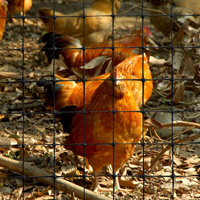A farm fence, often regarded as the silent guardian of […]
A farm fence, often regarded as the silent guardian of agricultural landscapes, is a vital element in the realm of farming and rural life. Serving multifaceted purposes, a farm fence is more than just a physical barrier; it delineates boundaries, safeguards livestock, protects crops, and contributes to the overall aesthetics of the countryside. With its diverse designs, materials, and functions, the farm fence is a testament to the marriage of practicality and rural tradition.
One of the primary functions of a farm fence is to provide a clear demarcation of property lines. In the vast expanse of farmland, these fences create well-defined borders, preventing encroachments and ensuring that land is used effectively. This delineation aids in efficient land management, helps prevent disputes, and facilitates the organization of farming activities.
A pivotal role that farm fences play is safeguarding livestock. Whether it's cattle, sheep, horses, or poultry, these barriers keep animals within designated grazing areas and shield them from potential dangers. Farm fences act as a first line of defense against predators and prevent domesticated animals from straying onto roadways, protecting both the livestock and passersby.
In crop agriculture, farm fences serve as indispensable shields against crop damage caused by wildlife, such as deer and rabbits. These barriers ensure that the hard work of planting and nurturing crops does not go to waste due to unwanted animal interference. By preventing these animals from accessing the crops, farm fences contribute to higher yields and reduced losses.
Farm fences also aid in erosion control and soil conservation. Wind and water erosion can be significant challenges on agricultural lands, but strategically placed fences act as windbreaks and help to retain soil, preventing topsoil loss. This function supports sustainable farming practices and contributes to maintaining the long-term productivity of the land.
The visual impact of a well-constructed farm fence should not be underestimated. Along rural roads, these fences add to the picturesque charm of the countryside, becoming an essential part of the landscape's character. Traditional wooden fences evoke a sense of nostalgia and connect modern farming with the agricultural heritage of the past.
Farm fences come in a variety of materials, including wood, metal, vinyl, and wire mesh, each offering unique benefits. Wooden fences exude a rustic aesthetic, blending seamlessly with the natural environment, while metal and vinyl fences provide durability and require less maintenance. Wire mesh fences offer flexibility and versatility, adapting well to different livestock containment needs.
Design considerations also play a significant role in the versatility of farm fences. Fences can be designed to be tall for privacy and security or low to provide unobstructed views of the landscape. Post and rail fences, split rail fences, and woven wire fences are just a few examples of the diverse designs that cater to various functional and aesthetic preferences.
In conclusion, a farm fence stands as an emblem of agricultural landscapes, offering a balance between function and form. Beyond its practical uses of defining boundaries, protecting livestock, and safeguarding crops, a farm fence embodies the character of rural life and tradition. As agriculture continues to evolve, the farm fence remains an enduring symbol of the vital connection between humans, the land, and the animals that inhabit it.



 WhatsApp:+8613626888261
WhatsApp:+8613626888261